Forests are among the most vital resources on our planet, providing essential benefits that support life on Earth. They generate clean air and water, preserve biodiversity, protect wildlife, and prevent soil degradation and desertification. Additionally, forests serve as significant carbon sinks, absorbing and storing large quantities of carbon dioxide, which is crucial in the efforts for nature restoration. Despite their immense value, forests are continually threatened by deforestation driven by activities such as illegal logging, agricultural expansion, and urban development.
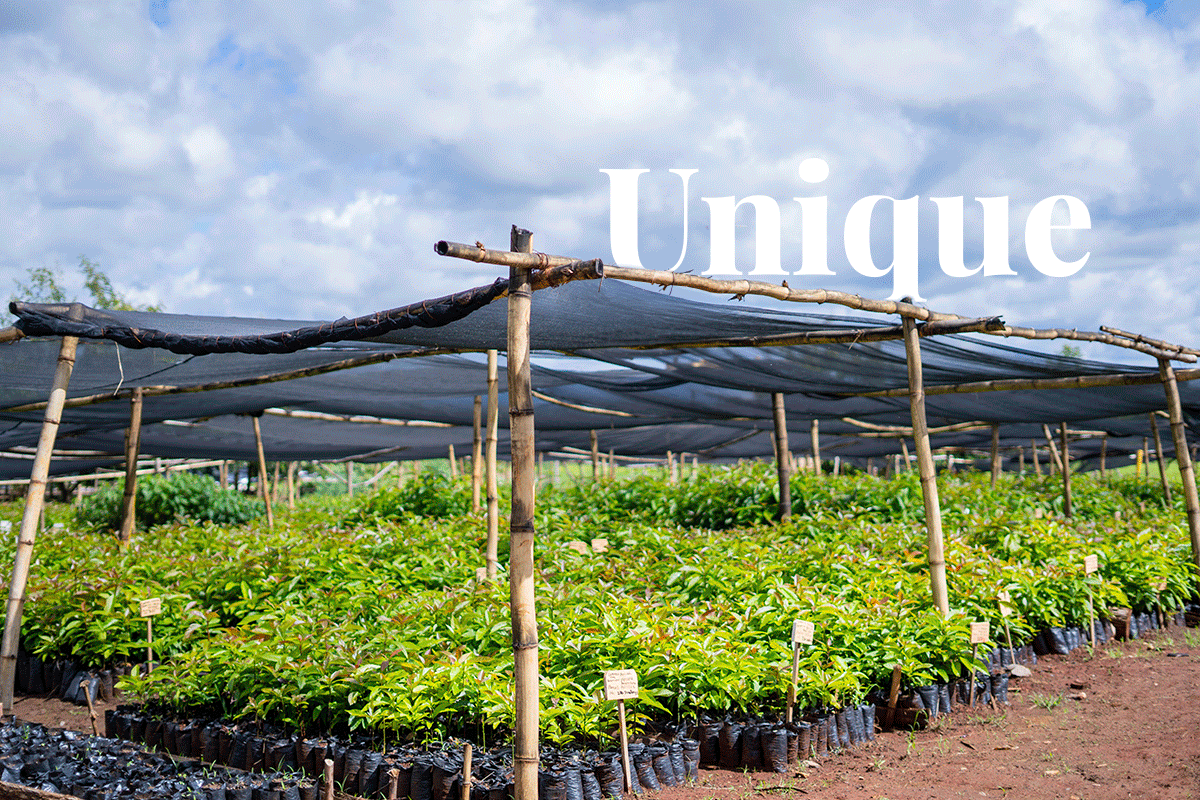 A picture of our lush tree nursery as part of the Hongera Reforestation Project, Kenya.
A picture of our lush tree nursery as part of the Hongera Reforestation Project, Kenya.
DGB Group is dedicated to combating these threats through large-scale reforestation and afforestation projects. Our mission revolves around restoring and protecting forests worldwide to revive ecosystems, enhance biodiversity, and restore nature. We believe that nature-based solutions are integral to both environmental and community wellbeing. By planting millions of trees across various regions, DGB aims to restore nature and support the socio-economic development of local communities.
Our approach is not just about planting trees; it’s about creating sustainable ecosystems and improving the livelihoods of people who depend on these forests. DGB’s projects meticulously select tree species that are beneficial to both the environment and the local economy. This dual focus ensures a harmonious balance between ecological restoration and socio-economic benefits, making our reforestation efforts unique and impactful.
Explore DGB’s nature-based projects
The impact of DGB’s reforestation projects
DGB’s reforestation projects stand out due to their comprehensive approach, addressing both environmental and socio-economic needs. Unlike traditional reforestation efforts that might focus solely on planting trees, our projects aim to restore degraded lands while simultaneously enhancing the quality of life for local communities and teaching them about the importance of sustaining forests. This holistic strategy ensures that our initiatives are sustainable and provide long-term benefits for both nature and people.
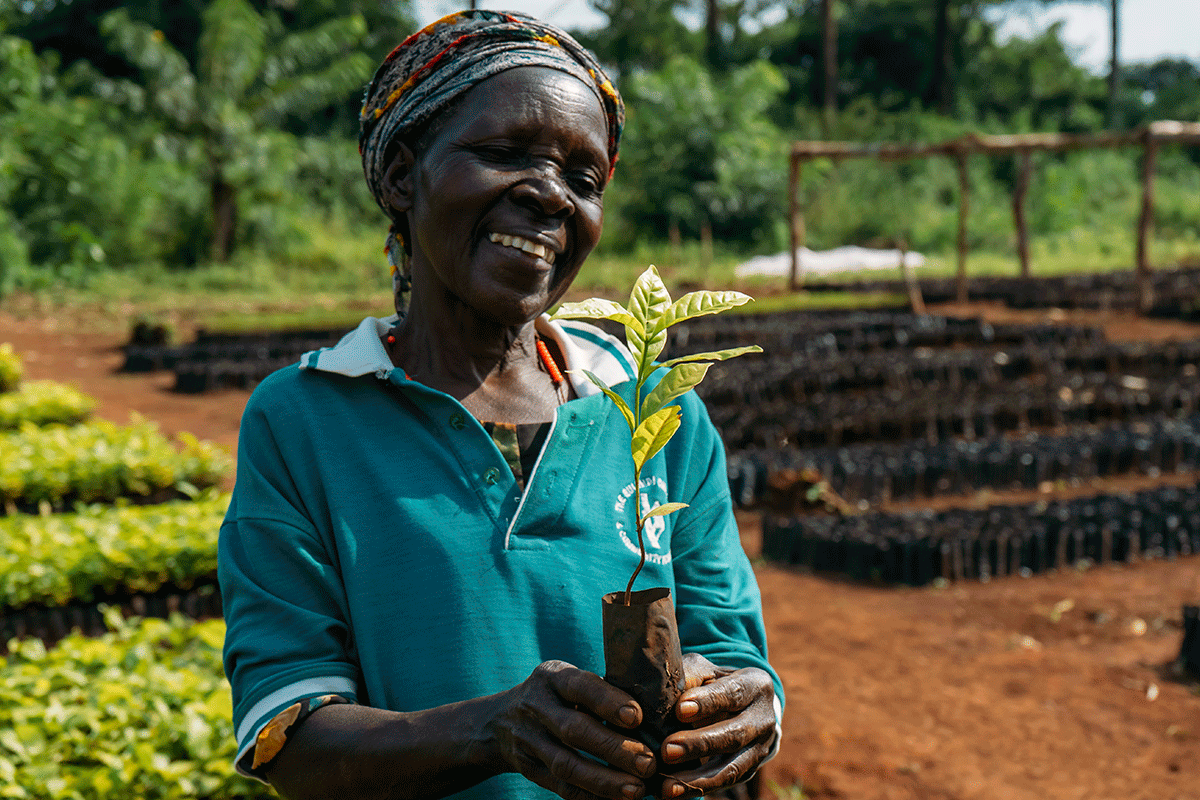 A picture of one of our workers holding a seedling, ready to be planted as part of the Bulindi Chimpanzee Habitat Restoration Project, Uganda.
A picture of one of our workers holding a seedling, ready to be planted as part of the Bulindi Chimpanzee Habitat Restoration Project, Uganda.
Another aspect that sets our projects and DGB apart is our boots-on-the-ground approach. With our experts of agronomists, ecologists, and foresters, we take a hands-on approach to project development with a strong emphasis on direct, in-country involvement and presence, ensuring the effective implementation of our projects and their benefits.
Read more: Reforestation: 10 amazing benefits of planting trees
A distinctive feature of DGB’s projects is the meticulous selection of tree species. We base our choices on five primary considerations: environmental compatibility, availability, carbon sequestration potential, economic benefits, and biodiversity. This careful selection ensures that each tree species we plant is suited to the local environment and contributes positively to the ecosystem. For example, we plant a variety of indigenous fruit trees, nut trees, and shade trees that are well-adapted to local conditions and beneficial to the communities. Some species are chosen for their ability to sequester large amounts of carbon, while others are selected for their crop value, providing direct economic benefits to local farmers.
Read more: The rich tapestry of trees in DGB’s reforestation projects: empowering local communities
DGB’s reforestation projects have a profound impact on the environment. Our projects significantly enhance biodiversity by reintroducing native species and creating diverse ecosystems. This biodiversity boost helps stabilise and enrich local habitats, supporting a wide array of wildlife and plant species. Improved soil health is another critical benefit; the newly planted trees prevent soil erosion, enhance nutrient cycling, and increase organic matter, leading to more fertile and productive lands. Moreover, our projects improve water retention in the soil, which is crucial for sustaining agricultural activities and maintaining local water cycles.
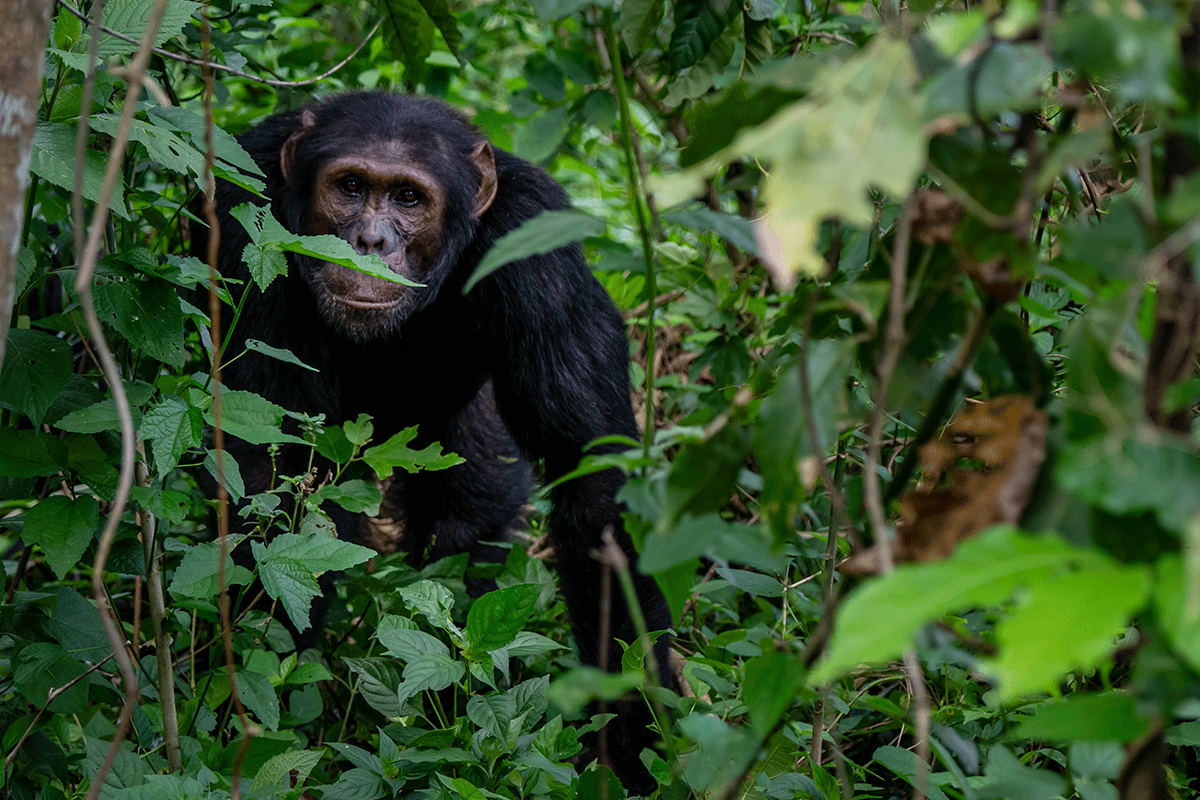 A visual of a wild chimpanzee staring curiously at the camera, captured in one of the forests near our nurseries at the Bulindi Chimpanzee Habitat Restoration Project, Uganda.
A visual of a wild chimpanzee staring curiously at the camera, captured in one of the forests near our nurseries at the Bulindi Chimpanzee Habitat Restoration Project, Uganda.
Our reforestation efforts go beyond environmental restoration; they focus on improving livelihoods and fostering resilience and prosperity in local communities. By incorporating agroforestry practices, we enable communities to derive income from fruits and cash crops harvested from the trees. This approach allows farmers to diversify their crops, increasing food security and generating additional income. It supports local economies and promotes sustainable land-use practices. Revenue from these crops, along with a fair share of carbon unit sales, helps uplift communities economically while ensuring the sustainability of our projects.
Read more: How nature-based projects contribute to net-zero goals
On the socio-economic front, DGB’s reforestation projects provide numerous benefits to local communities, transforming their economic stability and quality of life. Community engagement and collaboration are fundamental to the success of our reforestation projects. We work closely with local communities to ensure our projects align with their needs and priorities. This involves conducting local consultations, developing community-specific projects, and providing training and resources to support local livelihoods.
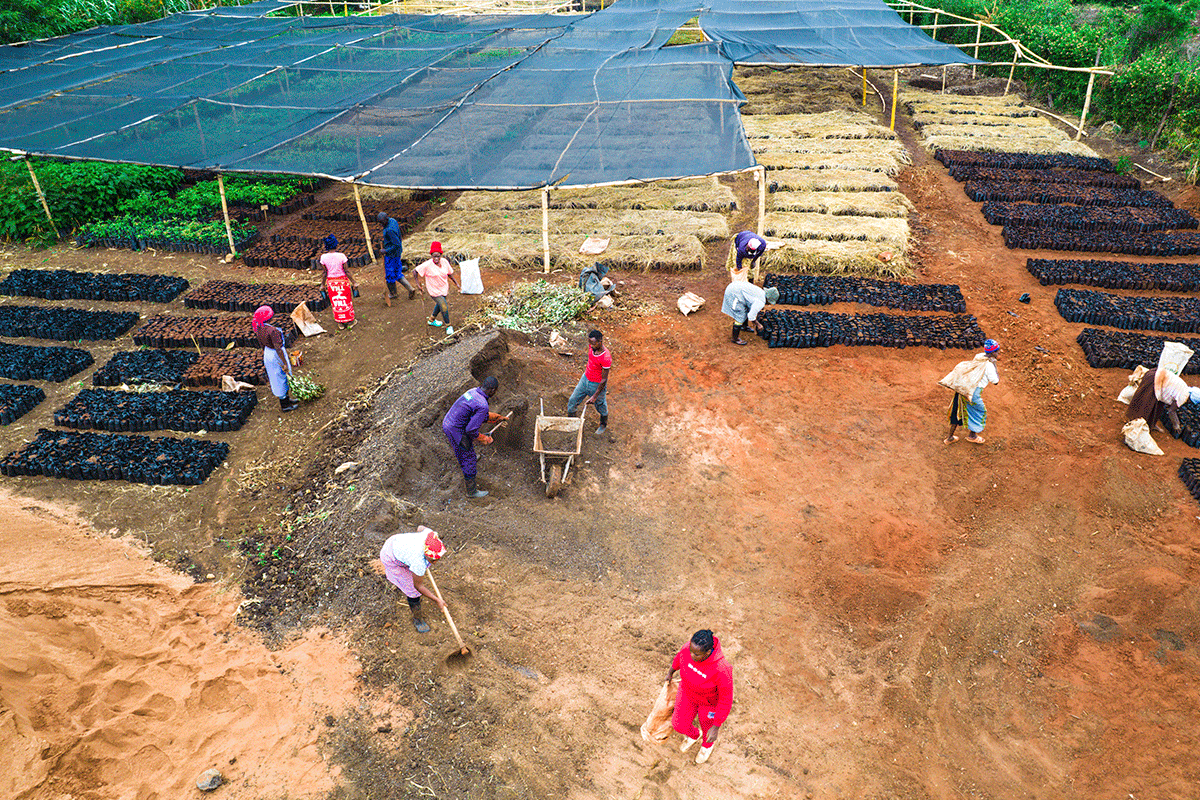 A drone picture capturing local workers during the tree nursery expansion at the Hongera Reforestation Project, Kenya.
A drone picture capturing local workers during the tree nursery expansion at the Hongera Reforestation Project, Kenya.
The creation of jobs in tree planting, maintenance, and agroforestry activities offers vital employment opportunities, particularly in rural areas where job prospects are often limited. These jobs provide a stable source of income, helping to alleviate poverty and improve living standards. By involving communities at every stage, we foster a sense of ownership and responsibility towards the projects, which is crucial for the long-term sustainability and success of our reforestation efforts.
Watch our exclusive webinar: The Power of High-Quality Carbon Projects—Kenya
Beyond direct economic benefits, DGB invests in promoting essential community services such as education, healthcare, and infrastructure. For example, we support school sponsorship schemes, provide training in conservation and sustainable farming practices, and improve access to clean water through the construction of village boreholes. These investments enhance the overall quality of life, fostering healthier, more resilient communities.
Read more: Sustainability simplified: Carbon footprinting for beginners
DGB’s commitment to long-term sustainability is evident in the design and execution of our projects. Each initiative reflects our dedication to restoring nature, protecting biodiversity, and promoting sustainable development. We utilise advanced monitoring and evaluation techniques to track the progress and impact of our projects. This technological integration allows us to make informed decisions and adapt our strategies as needed, ensuring that our projects continue to achieve their goals over time.
Read more: Sustainability simplified II: Carbon units for beginners
To sum up, DGB’s reforestation projects are unique due to their holistic hands-on approach, careful species selection, focus on community engagement, and commitment to sustainability. By combining environmental restoration with socio-economic development, we create projects that not only revive degraded lands but also enhance the wellbeing and prosperity of local communities. This integrated strategy ensures that the benefits of our reforestation efforts are felt by both the environment and the people who depend on it, making our projects truly transformative.
Read more: 100 Reasons carbon credits are the best thing that ever happened to improve conditions on our planet
Detailed look at DGB Group’s key reforestation projects
Hongera Reforestation Project (Kenya)
The Hongera Reforestation Project in Kenya is a large-scale initiative aimed at restoring previously forested areas that have been severely affected by human activities such as illegal logging, agricultural clearance, development, and firewood collection. This project plans to plant over 10 million trees over a seven-year period, focusing on critical catchment areas such as Mount Kenya and the Aberdares. By doing so, the project seeks to protect biodiversity, enhance water security, and improve the overall quality of life for local communities.
A key aspect of the Hongera Reforestation Project is its emphasis on community involvement and economic upliftment. The project provides job opportunities and training for local people, particularly smallholder farmers who rely heavily on the land for their livelihoods. By planting a mix of fruit trees, indigenous trees, and shade trees, the project restores the natural environment and provides valuable resources for the communities. The fruit trees, for example, yield crops that the farmers can sell or consume, thus directly improving their economic situation.
Read more: The Hongera Reforestation journey unfolds in 2024
Environmentally, the project has significant positive impacts. The newly planted trees help sequester carbon dioxide, thus contributing to clean air. Additionally, they improve soil health and water retention, which are crucial for sustaining agriculture and maintaining the ecological balance. By involving local Community Forest Associations, the project ensures that the benefits of reforestation are distributed equitably and sustainably among the people living in these areas. This collaborative approach fosters a sense of ownership and responsibility, which is vital for the long-term success of the reforestation efforts.
Watch an exclusive interview with Haron Wachira, our Project Director in Kenya
Greenzone Reforestation Project (Cameroon)
The Greenzone Reforestation Project in Cameroon is another large-scale nature-based solution initiative, aiming to plant over 16 million trees in the Congo Basin region over seven years. The project is the largest registered carbon project in the country and hosts the second-largest tree nursery. It is designed to re-establish tree cover on community-owned lands, which were once heavily forested but have since been overtaken by fast-growing bushes due to deforestation. By planting indigenous trees, the project aims to restore biodiversity and create a buffer against environmental degradation. It also provides food security, market access, and additional income for the communities.
A unique feature of the Greenzone Project is its integration of advanced technology for monitoring and managing reforestation activities. The project employs a combination of data from on-the-ground sensors, aerial drones, satellites, and machine-learning models to monitor biodiversity and predict future trends. This technological approach ensures that the project is executed to the highest standards and allows for adaptive management based on real-time data.
Read more: New growth in Cameroon
Community engagement is at the heart of the Greenzone Reforestation Project. The initiative works closely with local Chiefdoms and other community groups to ensure the project aligns with local needs and priorities. Moreover, the project supports local economies by providing jobs and improving infrastructure, healthcare, and education. This comprehensive approach ensures that the environmental benefits of reforestation are complemented by substantial social and economic improvements.
Read more: Greenzone Reforestation Project: cashew trees thriving in our latest planting season
Bulindi Chimpanzee Habitat Restoration Project (Uganda)
The Bulindi Chimpanzee Habitat Restoration Project in western Uganda is an afforestation initiative focused on protecting the habitat of the endangered Bulindi chimpanzees while supporting local village households. Established in collaboration with the Bulindi Chimpanzee and Community Project (BCCP), the project addresses the urgent conservation needs in the Hoima and Masindi districts, where over 300 wild chimpanzees live in fragmented forest areas.
The project employs a community-centric approach to conservation, working closely with local households to find sustainable solutions that benefit both the chimpanzees and the people. One of the main strategies is providing energy-saving stoves and seedlings for woodlots, which reduce pressure on the remaining natural forests and help protect the chimpanzees’ habitat.
Read more: Conservation triumph: the Bulindi Chimpanzee Project shines on Planet Earth III
In addition to environmental benefits, the project offers extensive training to local communities in conservation farming, erosion control, and leadership skills. These trainings not only enhance the local capacity for sustainable land management but also provide new income sources, thereby improving the overall quality of life for the villagers. The project also invests in children’s education through a school sponsorship scheme and supports small household projects such as house construction and coffee cash-cropping.
Read more: How the reforestation project in Uganda benefits the Bulindi chimpanzees
Lake Aral Afforestation Project (Kazakhstan)
The Lake Aral Afforestation Project in Kazakhstan is focused on reclaiming and restoring the dried banks of the Aral Sea by planting saxaul (Haloxylon), a hardy, salt-tolerant tree species well suited to the area. This project aims to create new saxaul ecosystems that will stabilise the soil, improve air quality, and mitigate the adverse impacts of sand-salt storms in the region. The Aral Sea’s desiccation has led to severe environmental issues, including increased levels of salt, dust, and sand that negatively impact human health and the local ecology. The project also incorporates improved grazing techniques to ensure the sustainability of the new ecosystems.
Read more: From dust to lush: the revitalisation of Lake Aral’s banks
The project emphasises collaboration with local communities, governments, and other stakeholders to ensure it is implemented sustainably and responsibly. This ensures that the project benefits are shared equitably, providing jobs and economic opportunities for local communities. By improving the environmental conditions in the Kyzylorda Region and providing economic benefits to the local population, the project aims to create a sustainable and resilient future for the area.
DRC Reforestation Project (Democratic Republic of the Congo)
The DRC Reforestation Project is an initiative aimed at restoring over 22,000 hectares of degraded land in the Democratic Republic of the Congo. This project focuses on planting indigenous species to revitalise the landscape, enhance biodiversity, and create sustainable economic opportunities for local communities. Restoring these degraded lands is crucial for the health of the ecosystem and the wellbeing of the people who depend on it.
One of the primary project goals is to provide employment opportunities for local residents in tree planting, maintenance, and related activities. This improves economic circumstances and ensures the local population is actively involved in the restoration efforts. The project also promotes sustainable agricultural practices, enhancing food security and encouraging environmentally sound methods that benefit both the land and the people. The project will also channel resources into key services such as education and healthcare, addressing crucial needs in the underserved rural areas of the DRC.
Key aspects of DGB Group’s approach
Holistic species selection
One of the standout features of DGB’s reforestation projects is our meticulous species selection process. We prioritise environmental compatibility to ensure the chosen species thrive in their native habitats and contribute positively to the local ecosystem. By selecting species naturally adapted to the region, we minimise the risk of introducing invasive species. This careful selection also considers the availability of species, ensuring that we use locally sourced seeds and seedlings, which supports local nurseries and job creation and reduces transportation emissions.
Read more: Ugly species need biodiversity protection too
In addition to environmental factors, we consider the carbon sequestration potential of each species. Trees that are effective at absorbing and storing carbon dioxide are prioritised to maximise the nature conservation benefits of our projects.
Economic benefits are also a key consideration; we plant species that provide valuable resources to local communities, such as fruit and nut trees—like avocado, cashew, macadamia, pear, apple, orange, lemon and many more—which can be harvested for food or income.
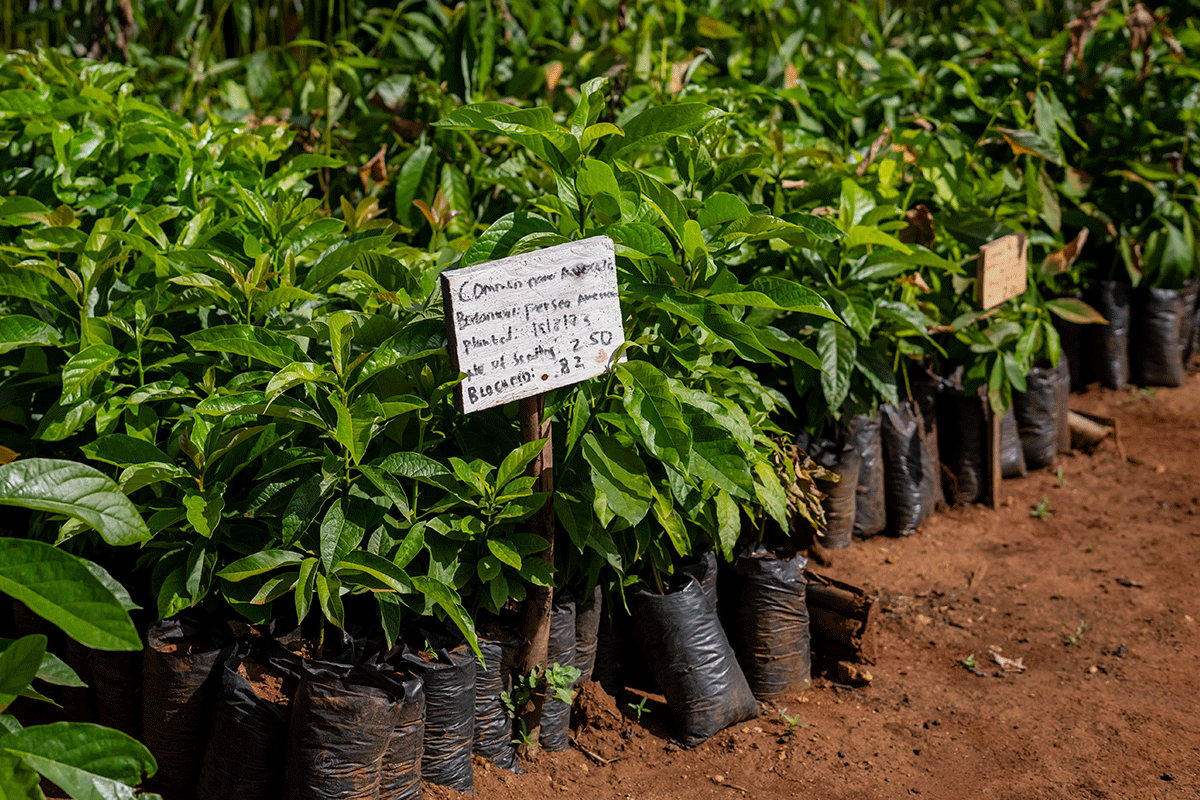 A picture of a group of avocado seedlings ready to be planted in our Hongera Reforestation Project nurseries, Kenya
A picture of a group of avocado seedlings ready to be planted in our Hongera Reforestation Project nurseries, Kenya
Finally, we emphasise biodiversity by incorporating a diverse mix of species, which enhances ecosystem stability and resilience. This holistic approach ensures that every tree planted contributes to a sustainable and thriving ecosystem while providing tangible benefits to the people who live there.
Community engagement
Community engagement is at the core of DGB’s reforestation efforts. We recognise that the success and sustainability of our projects depend on the active participation and support of local communities. From the outset, we work closely with local stakeholders to ensure our projects align with their needs and priorities. This collaborative approach involves undertaking local consultations to gather input and feedback.
To foster a sense of ownership and responsibility, we develop community-specific initiatives that address local challenges and opportunities. Providing training and resources is a crucial part of this process. We equip community members with the skills and knowledge they need to participate in and benefit from our reforestation efforts. This includes training in sustainable farming practices, forest management, and conservation techniques. By empowering local communities, we create lasting positive impacts that extend beyond the immediate goals of reforestation.
Integrating socio-economic benefits
Our projects provide local communities with new sources of income through the harvesting of fruits, nuts, and cash crops. This not only boosts local economies but also encourages sustainable land-use practices. The revenue generated from these crops, along with a fair share of carbon unit credit sales, helps uplift communities economically while ensuring the sustainability of our reforestation efforts.
In addition to economic benefits, our projects have significant social impacts. We invest in essential services such as education, healthcare, and infrastructure, which improve the overall quality of life for the communities involved. By addressing these critical needs, we create a foundation for sustainable development and long-term prosperity.
Long-term sustainability
DGB is deeply committed to the long-term sustainability of our reforestation projects. This commitment is reflected in every aspect of our project design and implementation. We use advanced monitoring and evaluation techniques to track the progress and impact of our projects, allowing us to make informed decisions and adapt our strategies as needed to ensure ongoing success.
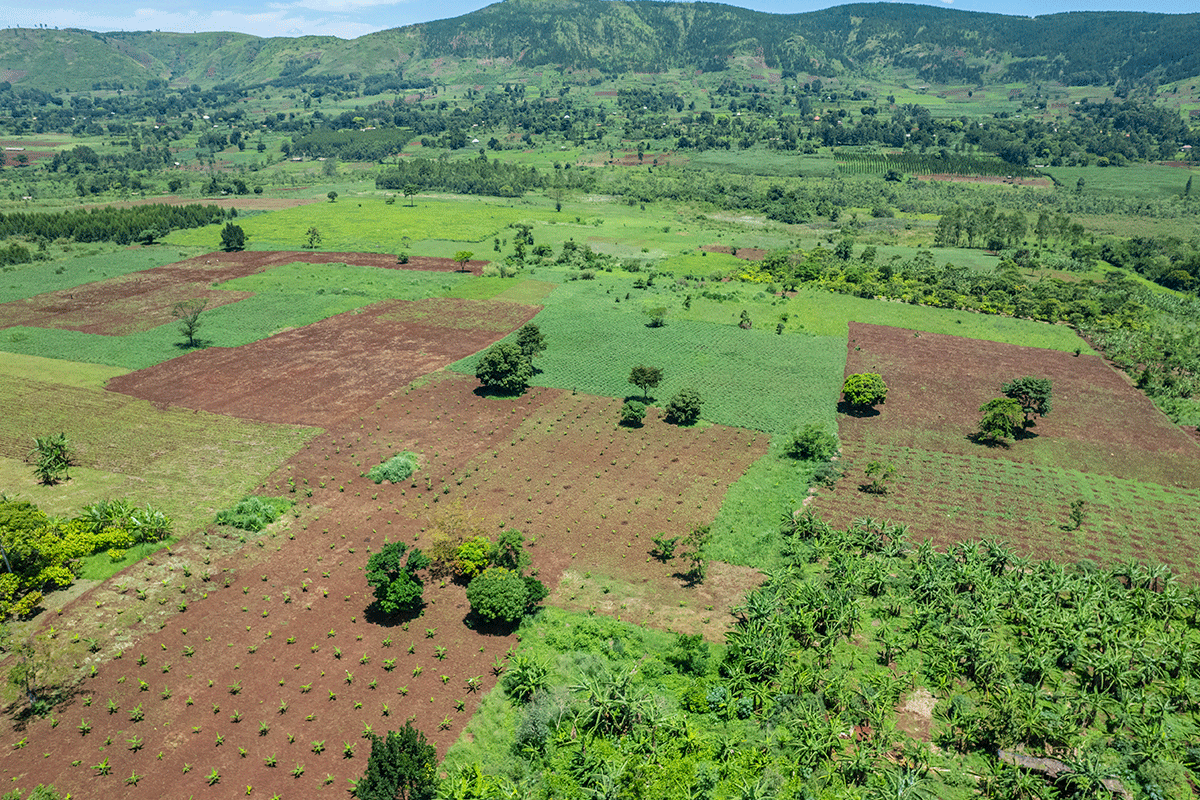 Trees already planted in a farmer’s plot of land in Bulindi, Uganda, as part of our reforestation efforts.
Trees already planted in a farmer’s plot of land in Bulindi, Uganda, as part of our reforestation efforts.
Our focus on sustainability extends to the economic and social dimensions of our projects. We ensure that the benefits of reforestation are equitably distributed among local communities, providing them with new sources of income and improved quality of life. Additionally, the long-term environmental benefits, such as improved soil health and water security, further enhance the resilience and sustainability of the communities involved.
Technological integration
DGB leverages cutting-edge technology to enhance the effectiveness and efficiency of our reforestation projects. We use a combination of data from on-the-ground sensors, aerial drones, satellites, and machine-learning models to monitor biodiversity and predict future trends. This technological integration allows us to track the growth and health of our trees, assess carbon sequestration rates, and detect any potential issues early on. By using technology to gather and analyse data, we can continuously improve our reforestation strategies. By staying at the forefront of technological innovation, DGB ensures that our reforestation projects are as effective and sustainable as possible.
Verification
DGB’s reforestation projects undergo rigorous verification to ensure transparency, credibility, and sustainability. Each project is developed according to leading verification standards such as Verra’s Verified Carbon Standard or the Gold Standard. Our projects are designed and implemented under frameworks that meet global best practices, ensuring that they not only contribute to carbon sequestration but also enhance biodiversity and support local communities. DGB’s adherence to stringent verification protocols ensures that our reforestation efforts deliver genuine, measurable environmental benefits, reinforcing stakeholder confidence and promoting sustainable development.
DGB Group’s continued commitment to nature: an invitation to join forces
DGB’s reforestation projects represent a tangible solution in a world grappling with environmental degradation and socio-economic challenges. Our unique approach, which seamlessly integrates meticulous species selection, community engagement, and long-term sustainability, sets us apart from conventional reforestation efforts. We don’t just plant trees; we cultivate ecosystems and nurture communities, ensuring that every tree we plant serves a dual purpose: to heal the planet and uplift the people.
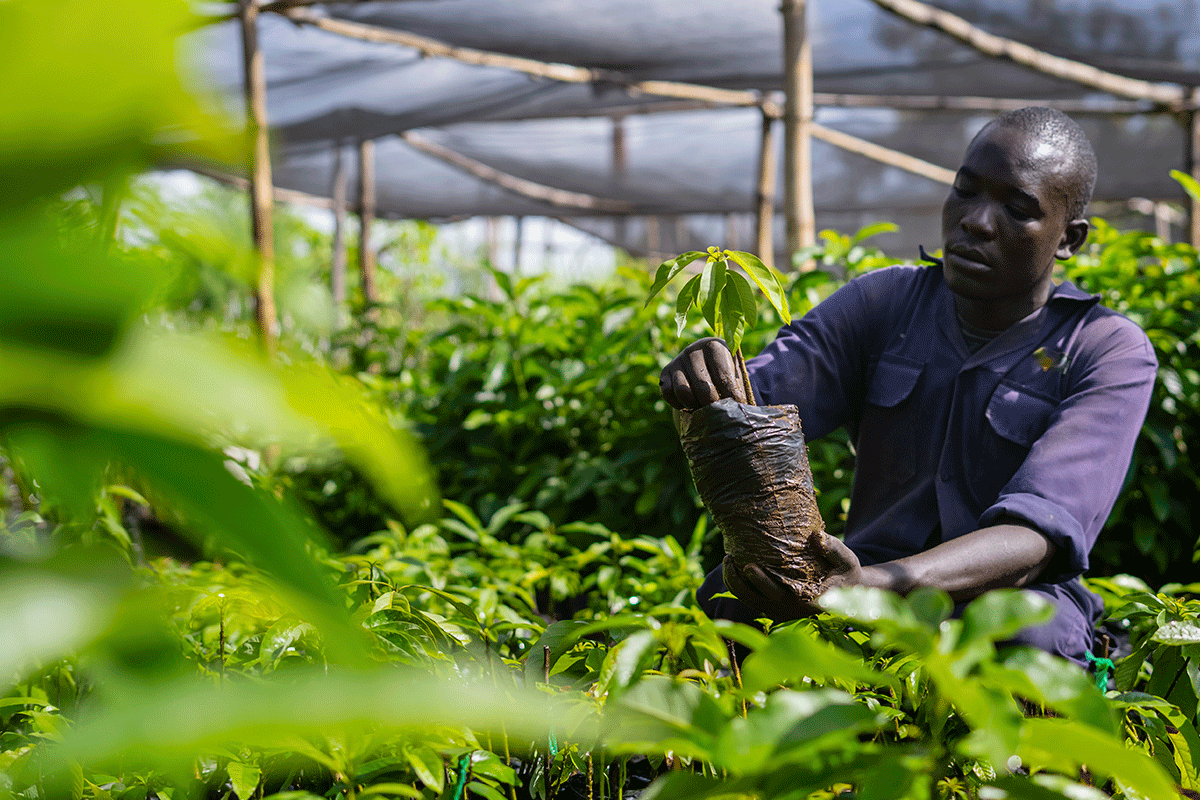 One of our workers at the Hongera Reforestation Project in Kenya, meticulously checking a mature avocado seedling ready to be delivered.
One of our workers at the Hongera Reforestation Project in Kenya, meticulously checking a mature avocado seedling ready to be delivered.
Our projects demonstrate that environmental restoration and socio-economic development are not mutually exclusive but can be harmoniously achieved. By restoring degraded lands, enhancing biodiversity, and sequestering carbon, we contribute significantly to global efforts to protect nature. Simultaneously, by providing local communities with sustainable livelihoods, we foster resilience and prosperity, breaking the cycle of poverty and environmental degradation.
Each DGB project is a testament to our unwavering commitment to creating a healthier, more sustainable future. We invite you to join us in this transformative journey. Whether through investing in our initiatives with green bonds, compensating for your environmental impact with our carbon units, or planting trees through our tree-planting subscription, your involvement can make a tangible difference. Together, we can restore forests, protect biodiversity, and create a greener tomorrow.
Join us in this mission. Be a part of the change. Let’s create a legacy of restoration and protection for our planet.
Discover the impact you can have on nature—download our carbon units brochure
- SEO Powered Content & PR Distribution. Get Amplified Today.
- PlatoData.Network Vertical Generative Ai. Empower Yourself. Access Here.
- PlatoAiStream. Web3 Intelligence. Knowledge Amplified. Access Here.
- PlatoESG. Carbon, CleanTech, Energy, Environment, Solar, Waste Management. Access Here.
- PlatoHealth. Biotech and Clinical Trials Intelligence. Access Here.
- Source: https://www.green.earth/blog/what-makes-dgbs-reforestation-projects-unique



